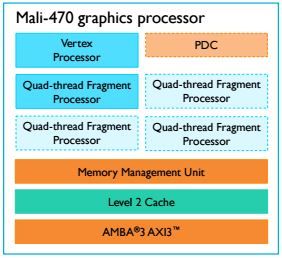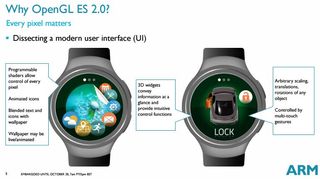ARM's New Mali-470 GPU Boasts Double The Efficiency Of Mali-400

ARM announced a new GPU from the same family as Mali-400 that uses only half as much power. The new GPU, the Mali-470, is targeted at next-generation wearables and IoT devices that need low-cost and low-power chips.
ARM seems to have outpaced Imagination in becoming the number-one GPU IP vendor with its Mali architecture. According to ARM, the company has 73 licensees who sold 550 million Mali-based GPUs in 2014 alone, and Mali is now in 75 percent of digital TVs, in more than 50 percent of tablets, and in over 35 percent of smartphones.

The new Mali-470 comes with support for the ubiquitous OpenGL ES 2.0 graphics API. According to ARM, it brings a strong balance between pixel control and energy efficiency, which makes it well-suited for user interfaces. Users aren't likely to play 3D games on their smartwatches any time soon, so OpenGL ES 3.0 and beyond shouldn't be necessary. (By the time it is, the more efficient Vulkan should be the de facto graphics API.)

Because OEMs didn't want a brand new architecture for a still-unproven market such as the wearables one, ARM decided to update the Mali-400 implementation for use in this market. The main changes were done to the vertex and fragment processors, which led to an increase in efficiency of 2x over Mali-400.
The Mali-470 GPU can be paired with both 32-bit Cortex-A7 and 64-bit Cortex-A53 CPUs. The new GPU also supports the latest versions of Android, Android Wear and other Linux kernel-based operating systems such as Tizen.
The new GPU can have one to four pixel processors in its implementations, and it will support screen resolutions ranging from 640 x 640 up to 1080p at 60 fps. The GPU can also turn off functional blocks when not in use, which can lead to a zero-percent power consumption for those parts of the GPU.

Although Mali-470 was designed mainly for use in wearables and IoT, we could also see it in lower-end smartphones in the future. As the new GPU was designed to support the same Mali-400 interfaces, it should be easy for OEMs and chip makers to swap Mali-400 for Mali-470 in their SoCs. Mali-470 is expected to arrive in devices late 2016.
Stay on the Cutting Edge
Join the experts who read Tom's Hardware for the inside track on enthusiast PC tech news — and have for over 25 years. We'll send breaking news and in-depth reviews of CPUs, GPUs, AI, maker hardware and more straight to your inbox.
______________________________________________________________________

Lucian Armasu joined Tom’s Hardware in early 2014. He writes news stories on mobile, chipsets, security, privacy, and anything else that might be of interest to him from the technology world. Outside of Tom’s Hardware, he dreams of becoming an entrepreneur.
You can follow him at @lucian_armasu. Follow us @tomshardware, on Facebook and on Google+.
Most Popular


